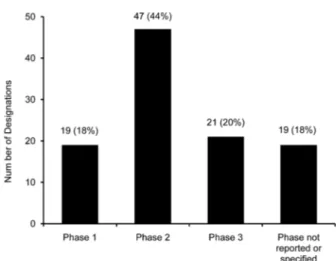1
희귀질환 연구와 치료제 개발 동향
이신행1,2·이장익1,2
1연세대학교 약학대학 종합약학연구소, 2연세대학교 약학대학 임상약학-규제과학 교실 (2013년 3월 2일 접수·2013년 3월 12일 수정·2013년 3월 14일 승인)
Rare Disease Research and Orphan Drug Development
Shinhaeng Lee
1,2and Jangik I. Lee
1,21Yonsei Institute of Pharmaceutical Sciences, Yonsei University, 162-1 Songdo-dong, Yeonsu-gu, Incheon 406-840, Republic of Korea
2College of Pharmacy, Yonsei University, 162-1 Songdo-dong, Yeonsu-gu, Incheon 406-840, Republic of Korea (Received March 2, 2013·Revised March 12, 2013·Accepted March 14, 2013)
희귀질환이란 일반적으로 그 유병율이 인구 일만 명당 5명 이하인 질환을 말한다. 세계에는 약 7,000여종의 희귀질 환이 알려져 있고 학술지에 매 주 대략 5종의 새로운 희귀질환이 보고되고 있다. 희귀 의약품(orphan drug)이란 희 귀질환치료제 또는 수익성이 없어 개발을 기피하는 일반질환 치료제로서 정부가 지정한 의약품을 말한다. Orphan 의 약품의 개발에는 많은 장점이 있다. Orphan 의약품으로 정부의 지정을 받으면 세금감면을 통한 연구비 지원, 임상시 험 비용 지원, 신약허가 심사비 면제, 시장독점권 부여 등의 특혜가 주어진다. 희귀질환의 대부분은 단순한 유전적 결함에 의하는 경우가 많아 치료제의 표적발견이 비교적 쉬우므로 개발 성공률이 높고, 임상시험기간이 짧으며, 시판 허가를 받을 확률이 높아 연구개발비용이 적게 든다. 그 결과 전세계 orphan 의약품 시장은 최근 매년 6%씩 성장 하여 2014년에는 약 1,120억달러의 시장을 형성할 것으로 추정된다. Orphan 의약품 시장은 현재 매년 8.9%씩 성장 하고 글로벌 시장의 51%를 점유하는 미국을 중심으로 확장되어 가고 있으며, 총매출액의 64.3%가 유전자재조합의약 품에 의한 것으로 알려져 있다. 이러한 의약품시장의 변화와 사회적 요구에 부응하여 한국 또한 희귀질환 치료제 개 발의 활성화를 위해 재정적 지원체계를 구축하고, 허가관리를 개선하며, 법률적 제도를 완비하는 과정에 있다. 현재 희귀질환의 치료적 타겟을 찾아 신물질이나 기존의 약물을 발굴하는 과정이 주로 대학이나 연구 중심 병원에서 이루 어지고 있다. 제도가 잘 정립되어 있는 미국 시장을 겨낭하여 orphan 의약품 개발을 전략적으로 수행한다면 큰 성공 을 거둘 수 있을 것으로 기대된다.
□ Key words - rare disease, orphan drug, orphan designation, orphan drug act, academic institution
INTRODUCTION
A disease is categorized into a rare disease and a common disease based on the prevalence. Although the definition of a rare disease varies slightly in different countries, it is generally accepted as a disease with the prevalence of less than five in 10,000 people.
1)The incidence of a rare disease at birth is less than one in 2,000 people. It represents 6% to 8% of the world population. There are about 7,000 rare diseases already known and about 250 dis-
eases are newly reported in medical journals every year.
2)Approximately 80% of rare diseases are from genetic ori- gins. Other causes include infections, allergies, and prolifer- ations. Signs and symptoms of some rare diseases such as lysosomal storage diseases, patent ductus arteriosus, and cystic fibrosis may appear at birth or in childhood. How- ever, more than 50% of rare diseases appear during adult- hood. Examples of such diseases include glioma and acute myeloid leukemia.
3)Similar to a rare disease, an orphan drug is defined slightly differently in different countries.
1)In general, it is a drug intended to treat either a rare disease or a common disease where pharmaceutical manufacturers cannot expect to make profits from the sales of the drug. Drugs and vaccines for tropical diseases are good examples of
Correspondence to : Jangik I. Lee
College of Pharmacy, Yonsei University 162-1 Songdo-dong, Yeonsu-gu, Incheon 406-840 Republic of Korea Tel: +82-32-749-4505, Fax: +82-32-749-4105 E-mail: ike.lee@yonsei.ac.kr
